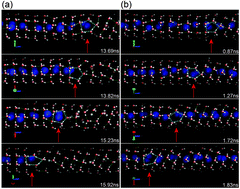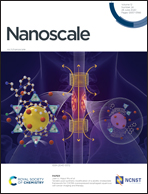Electric field triggered release of gas from a quasi-one-dimensional hydrate in the carbon nanotube†
Abstract
We systematically investigate the effects of an axial electric field on the formation and decomposition of quasi-one-dimensional nitrogen gas hydrates within a single-walled carbon nanotube (SWNT) by using molecular dynamics (MD) simulations. We find that the nitrogen hydrate in the SWNT undergoes a series of structure phase transitions with increasing electric field. Corresponding to the structure transition, the nitrogen gas releases from the carbon nanotube in the electric field range of 1 V nm−1 to 2 V nm−1. However, nitrogen molecules are trapped as guest molecules, forming a molecule wire, in the ice nanotube when the electric field is less than 1 V nm−1 or larger than 2 V nm−1. Our simulations indicate that the nanotube is an excellent tiny gas tank that can be used to trap gas molecules and control their release triggered sensitively by electric signals. The key to this phenomenon is the change in orientations of water dipoles induced by the electric field, which leads to the structural change in the hydrogen-bonding network and the change in the diffusion coefficient of the water molecules. Our findings here may help understanding the mechanism of the electrorelease of gas from hydrates confined in the nanoscale space.



 Please wait while we load your content...
Please wait while we load your content...